SEO
7 Steps to Grow Your Traffic & Sales

Content marketing has become one of the best (and most cost-effective) ways to get traffic to a website. When done right, the traffic keeps coming long after you stop actively promoting it.
If you own an e-commerce website and want to learn how to utilize blogging to grow your brand and increase your sales, this is the guide for you.
I’ve personally grown blogs to over 250,000 monthly visitors, and I’ve worked with dozens of clients in the e-commerce space to help them do the same. Here’s an overview of my seven-step process to starting and growing an e-commerce blog.
But first…
Creating a blog has a whole host of benefits for e-commerce websites:
- It can help you move visitors along your marketing funnel so they eventually buy.
- You’re able to rank highly for keywords on Google that your product pages could never rank for but that are still important for building brand awareness and finding customers.
- It can help you grow your email list.
- You’re able to continue to get traffic without constantly spending money on ads.
- It provides many opportunities to link to your product and category pages to help them rank better on the SERPs.
If you don’t know what some of these things mean, don’t worry—I’ll explain them along the way. But for now, let’s take a look at some e-commerce blogs that are working well right now so you can see the end goal.
Examples of successful e-commerce blogs
Three of my favorite examples of e-commerce websites using blogging are:
Solo Stove comes in at the top of my list due to its excellent use of videos, photos, and helpful information on the blog. It also does search engine optimization (SEO) really well, bringing in an estimated 329,000 monthly visits from Google (data from Ahrefs’ Site Explorer).

In fact, it’s grown its brand to such a level of popularity that it even created search demand for keywords that include its brand name in them, then created blog posts to rank for those keywords:
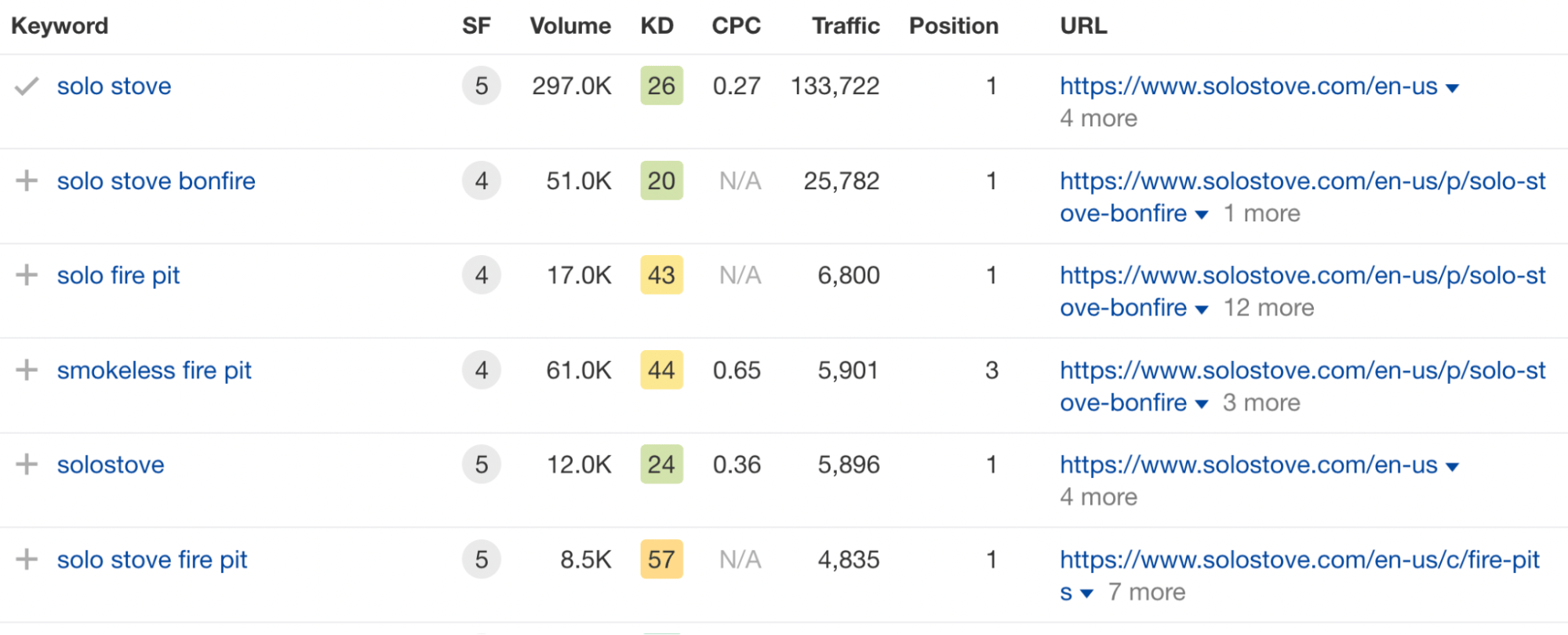
But that’s not all it did. Its blog posts also rank for other keywords in its marketing funnel, such as how to have a mosquito-free backyard or how to change your fire pit’s colors.
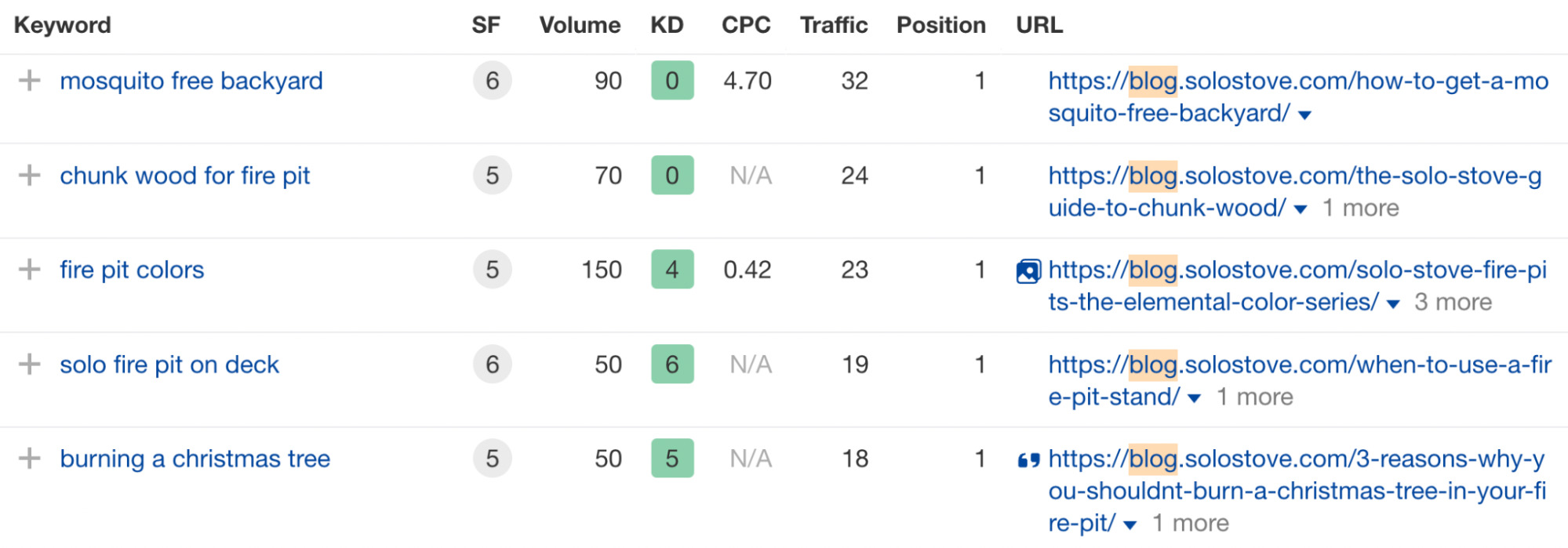
Then on its blog posts, it uses pictures of its fire pit:

Ranking for these keywords does two things:
- It introduces Solo Stove’s brand to people who may eventually purchase a fire pit from it.
- It gives the brand the opportunity to promote its products to an audience who may not have even known it existed, such as the “mosquito free backyard” keyword.
Moving on, skater brand Flatspot also does blogging well, with a cool ~80,000 monthly visitors to its blog just from search engines.
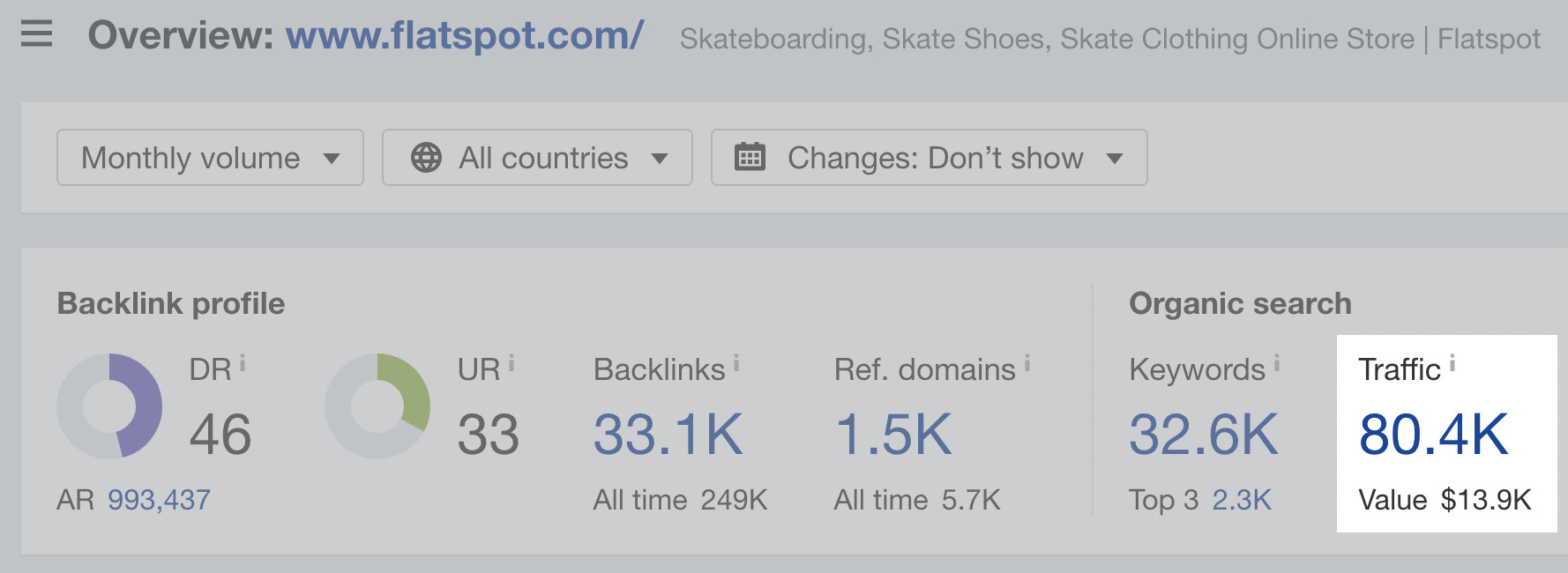
One of its tactics is to piggie-back on the popularity of new shoe releases from major brands like Nike, then use that traffic to get readers to buy the shoes directly from it:

Finally, let’s look at v-dog—a plant-powered kibble manufacturer that gets ~8,000 visits per month.
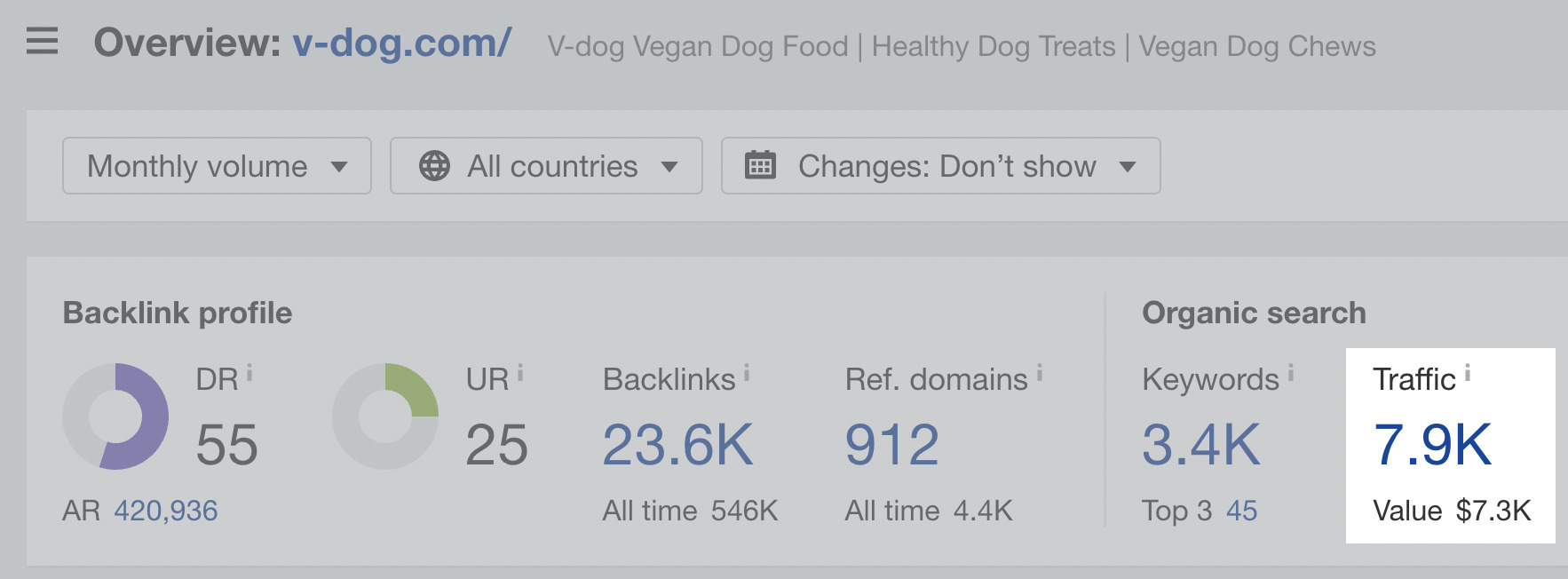
My favorite post it’s done is its guide to making wet dog food at home, which ranks for the featured snippet for “how to make wet dog food”:

This guide directly promotes v-dog’s product to make wet dog food. So people who search the query will be introduced to its brand and potentially buy its product to make their own wet dog food at home.
And there you have it—three examples of blogging for e-commerce that’s working right now. With that, let’s talk about how you can start your own blog.
In my 10+ years as a professional SEO and freelance writer, I’ve worked with over a dozen e-commerce stores to help them grow their website traffic. I’ve also run several of my own e-commerce websites.
In that time, I’ve distilled what works into an easy-to-follow seven-step process:
1. Do some keyword research
I never start a blog without first doing keyword research. Not only does this make coming up with blog topic ideas much easier, but it also ensures that every blog post you write has a chance to show up in Google search results and bring you free, recurring traffic.
While we wrote a complete guide to keyword research, here’s a quick and dirty strategy for finding keywords fast:
First, find a competitor who has a blog. Let’s say you’re selling dog food just like v-dog—if I search for “dog food” on Google, I can see some of my competition:
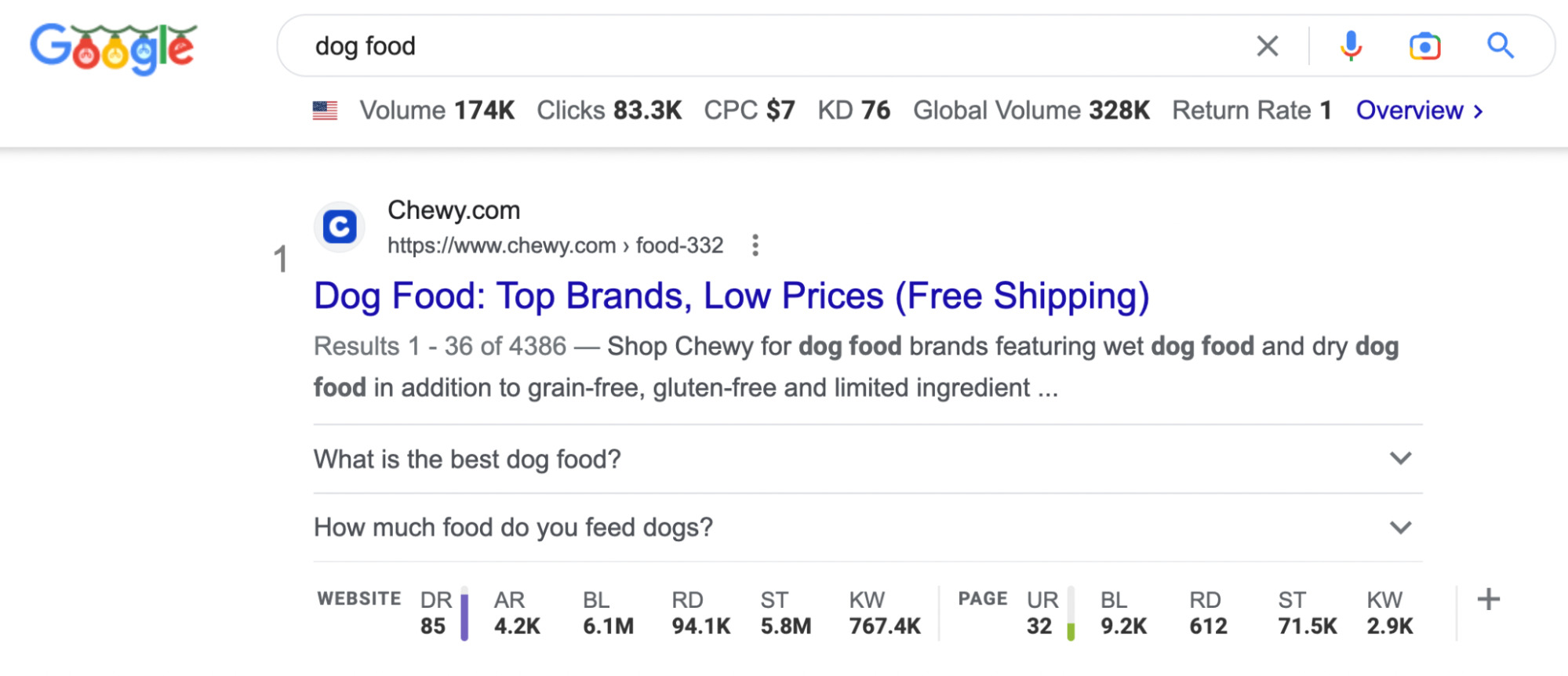
At this point, I look for relevant competitors. For example, Chewy and American Kennel Club are good competitors for research. But I’ll skip sites like Amazon and Walmart, as they are just too broad to get relevant data from.
Next, plug the competitor’s URL into Ahrefs’ Site Explorer and click on the Organic keywords report to see the keywords its website ranks for on Google:

In this example, it has over 700,000 keywords. That’s way too many to sort through. Let’s add some filters to make things easier:
- First, set the KD (Keyword Difficulty) score to a maximum of 30 to find easier-to-rank-for keywords.
- Then we can exclude brand name keywords using the “Keywords” dropdown, set it to “Doesn’t contain,” and type in the brand name.
- If the website has /blog/ in its blog post URLs, you can also set a filter in the “URL” dropdown to “Contains” and type “blog” in the text field. In Chewy’s case, it doesn’t do that, but it does use a subdomain for its blog, which we can search specifically.
When you’re done, it should look like this:

In the case of chewy.com, this only shaved it down to 619,000 keywords. That’s still a lot—let’s filter it down further. We can apply the following:
- Minimum monthly search volume of 100
- Only keywords in positions #1–10
- Only show keywords containing “dog,” since my example website only sells dog food, not all animal food
Here’s what it looks like with these new filters applied:

Now I can find some more related keywords like “what to feed a dog with diarrhea” or “can dogs eat cheese.”

In addition to picking interesting keywords, you can also get an idea of how to become a topical authority on the topic of dog food by searching “dog food” in Ahrefs’ Keywords Explorer.
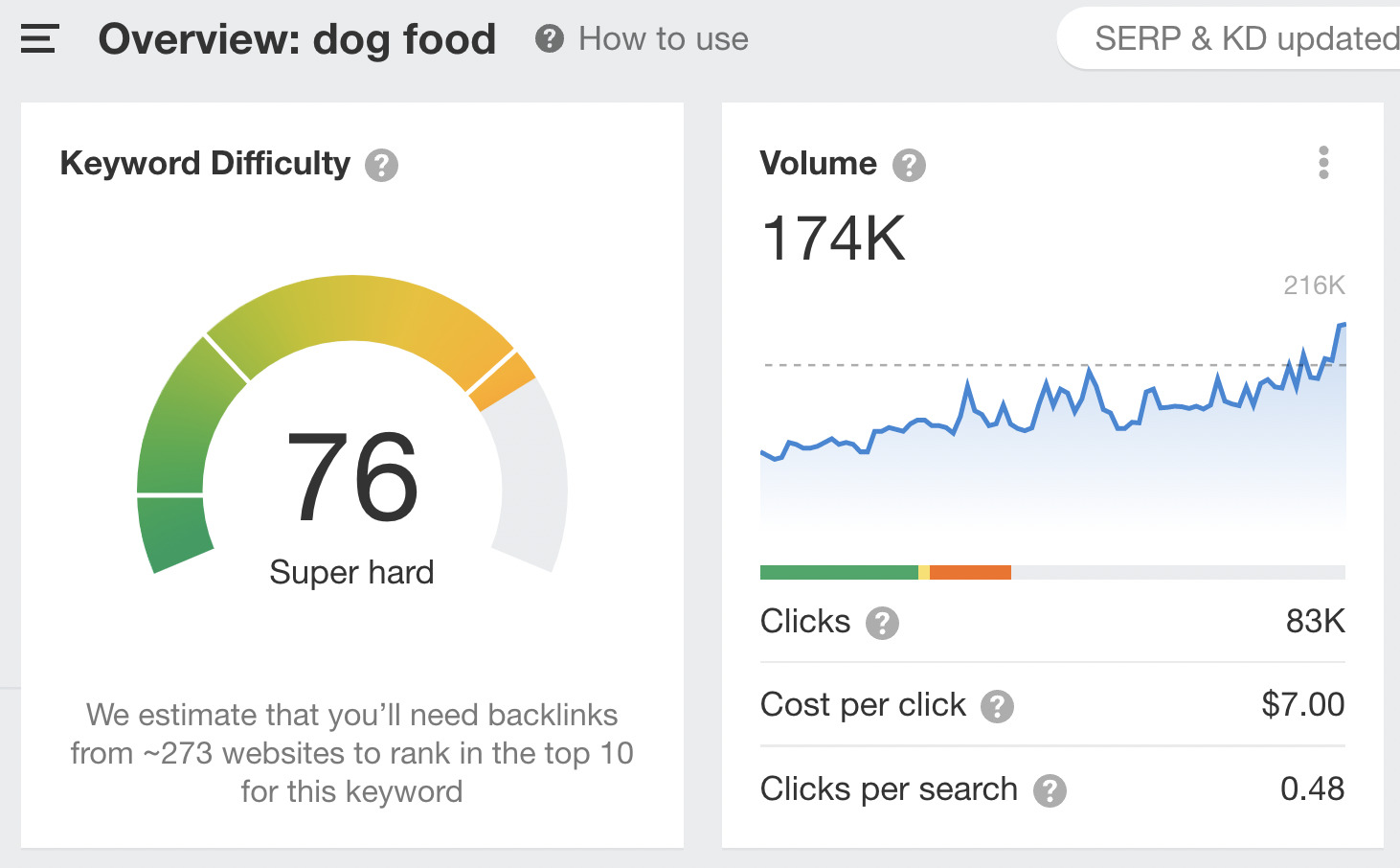
This keyword is extremely difficult to rank on page #1 for. However, if we go to the Related terms report and set the KD to a max of 30, we can see keyword ideas that are still relevant but may be easier to rank high in the search results.

Go through and click the gray + sign next to any keywords you may want to target to add them to your list of potential article ideas.
2. Create templates for future blog posts
One of the first things I do when I create a new blog is to establish a repeatable template that I use for every post. Typically, it looks something like this:
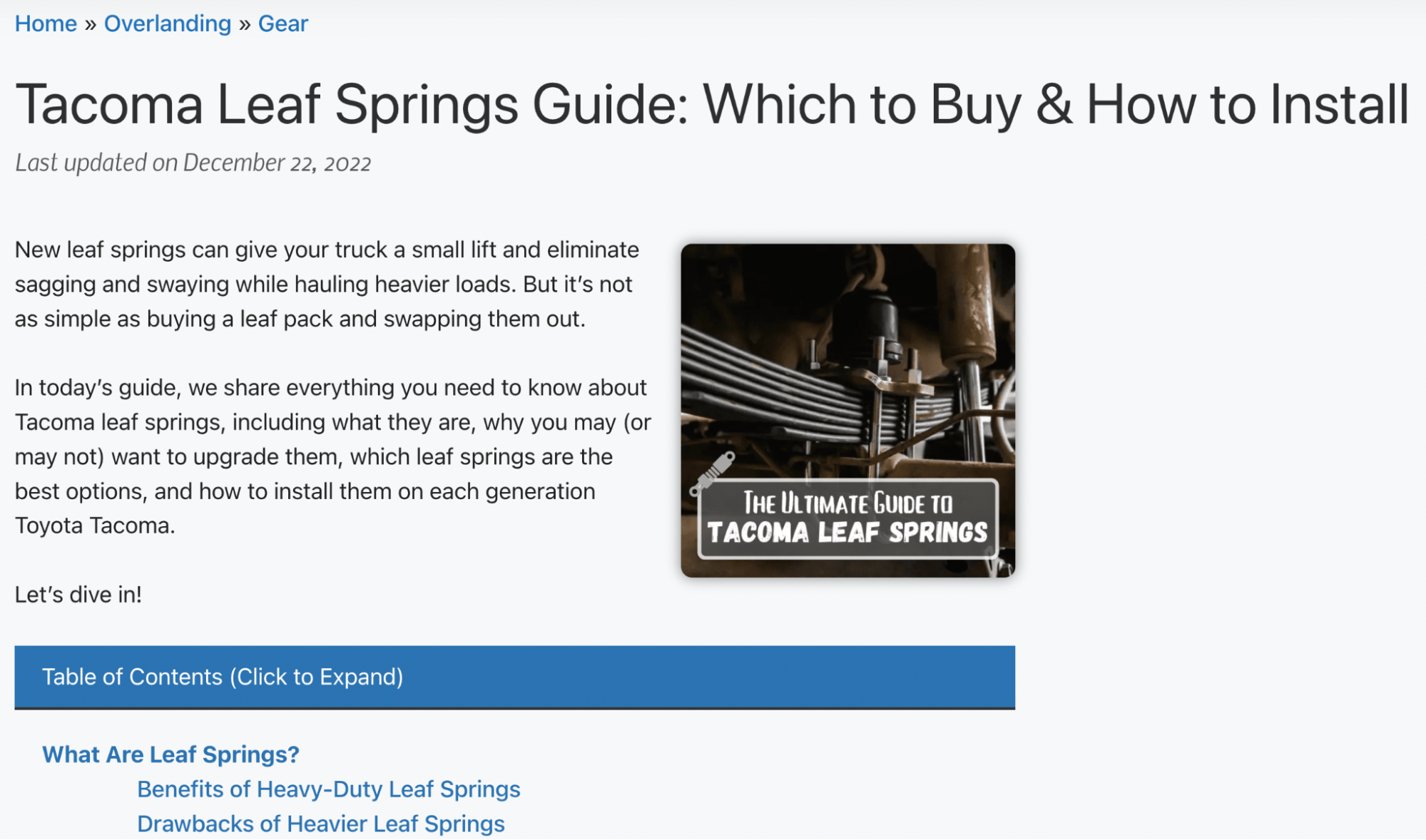
It has breadcrumb navigation to help with SEO and navigation, the article title and the date it was last updated, then a short intro with an image on the right to make the lines shorter (and easier to skim). Finally, I include a clickable table of contents to help with navigation, then get into the article.
Within the article itself, I will use headers (H2s) and subheaders (H3s) to make my content easier to skim and to help Google understand what each section is about.
You can make templates for every kind of post you plan on creating—such as list posts, ultimate guides, tutorials, etc.—and reuse them for every post you ever create. It’s a huge time-saver.
While you’re at it, you should also create a standard operating procedure (SOP) that you go through for every article. This could include writing guidelines, what to do with images, formatting, tone, etc.
3. Outline your article
I never dive into writing an article without outlining it first. An outline ensures the article is well structured and planned before you start writing, and it bakes SEO right into your writing process. It’s another big time-saver.
Typically, you want this outline to include:
- Potential title or titles of the article
- Target keyword
- Brief description of the article angle
- Links to competing articles on Google for research
- Headers and subheaders, with brief descriptions of the section as needed
Here’s a look at part of an example outline I’ll either send to my writers or write myself:
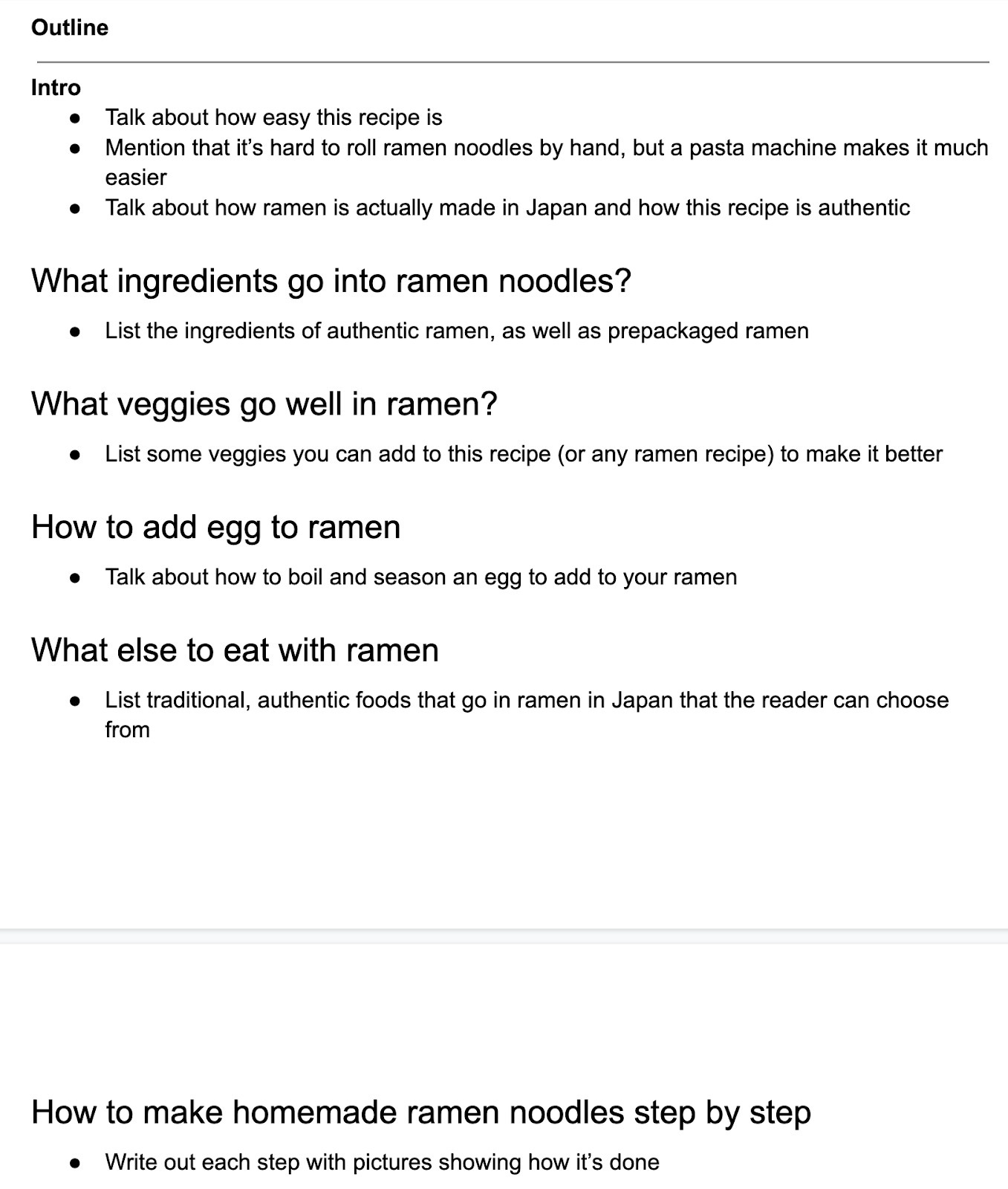
I wrote a guide to outlining content, which you can follow here for the full step-by-step process.
4. Write, optimize, and publish your post
Next up, it’s time to write your article. As you write more articles, you’ll find what works for you—but you may find it easier to fill in the sections then go back and write the intro once the article is finished.
Here are a few writing tips to help you become a better writer:
- Ditch the fluff – If a word isn’t needed to bring a point across, cut it.
- Keep your paragraphs short – Two to three lines per paragraph is plenty, especially for mobile readers where the screen width is shorter.
- Use active voice over passive voice – Here is a guide for that.
- Make your content easy to skim – Include photos and videos and make use of headers and bulleted lists to share key points.
Once you’ve written your article, do some basic on-page SEO to help it rank higher in search results:
- Ensure your article has one H1 tag – The title of the article.
- Have an SEO-friendly URL – Include the keyword you’re targeting, but keep it short and easy to read.
- Link to other pages on your site using proper anchor text – Here’s a guide for that.
- Ensure your images have alt text – This is the text Google uses to read what the image is about, as well as what is shown to readers if the image can’t render.
Finally, publish your post and give yourself a pat on the back.
5. Add product promotions, email opt-ins, and internal links
Before you promote your content, there are a few things you can do to squeeze more ROI from it—namely, you should add a way for people to either push them through the funnel toward purchasing a product or subscribe to your email list. I’ll give an example of each.
First, Solo Stove wrote an article titled “Ambiance Is A Girl’s Best Friend,” where it promotes its tiny Solo Stove Mesa as a way of improving a space’s ambiance:

Beyond directly promoting your products in the articles, you can also add email opt-ins that give people a percentage off their orders. You may lose a little money on the initial order. But once you get someone’s email address, you can promote to them again and get multiple orders from them.
For example, Primary sells kids’ clothing and uses this email pop-up to promote money off its products after you spend a certain amount of time on its website:

Just make sure your discount code only works once per unique IP address. You can learn more about how to do that here if you use Shopify.
Finally, when you publish an article, you should make it a point to add internal links to your new article from older articles.
This won’t be as important for your first few because you won’t have a ton of articles. But as your blog grows, it’s an important part of the process to ensure your readers (and Google) can still find your articles and that they aren’t buried deep on your site.
Refer to our guide to internal linking to learn more about this step.
6. Promote your content
At this point, your content is live and optimized for both conversions and search engines. Now it’s time to get some eyeballs on it.
We have an entire guide to content promotion you should read, but here are some highlights:
- Share the article on all of your social media channels
- Send the article to your email list if you have one
- Share your content in relevant communities (such as relevant Reddit forums)
- Consider running paid ads to your article
There’s a lot more you can do to promote a piece, including reaching out to other blog owners. But I won’t cover all of that here.
The other important piece of promoting your content is getting other website owners to link to your new articles. This is called link building, and it’s a crucial part of SEO.
There are many ways to build links. Some of the most popular include:
Link building is an entire subject on its own. If you’re serious about blogging and getting search traffic, it’s a crucial skill to learn.
7. Scale your efforts
The final step in blogging for e-commerce is scaling up your efforts by creating repeatable processes for each step and hiring people to do the tasks you yourself don’t need to be doing.
You can hire freelance writers, outreach specialists, editors, and more. You can put together a full SEO team for your business.
If you’re not in a place to start hiring, there are still things you can do to squeeze more output from your time, such as creating the SOPs I mentioned earlier.
Final thoughts
Blogging is one of the best ways to increase your e-commerce store’s traffic and sales. It costs less than traditional paid advertising and can continue to provide a return long after a post has been published.
This guide will hopefully help you start your e-commerce blog and publish your first post. But remember that success with blogging doesn’t happen overnight. In fact, it takes three to six months on average to see any results from your SEO efforts. Keep learning and be patient.
SEO
HARO Has Been Dead for a While

I know nothing about the new tool. I haven’t tried it. But after trying to use HARO recently, I can’t say I’m surprised or saddened by its death. It’s been a walking corpse for a while.
I used HARO way back in the day to build links. It worked. But a couple of months ago, I experienced the platform from the other side when I decided to try to source some “expert” insights for our posts.
After just a few minutes of work, I got hundreds of pitches:
So, I grabbed a cup of coffee and began to work through them. It didn’t take long before I lost the will to live. Every other pitch seemed like nothing more than lazy AI-generated nonsense from someone who definitely wasn’t an expert.
Here’s one of them:


Seriously. Who writes like that? I’m a self-confessed dullard (any fellow Dull Men’s Club members here?), and even I’m not that dull…
I don’t think I looked through more than 30-40 of the responses. I just couldn’t bring myself to do it. It felt like having a conversation with ChatGPT… and not a very good one!
Despite only reviewing a few dozen of the many pitches I received, one stood out to me:


Believe it or not, this response came from a past client of mine who runs an SEO agency in the UK. Given how knowledgeable and experienced he is (he actually taught me a lot about SEO back in the day when I used to hassle him with questions on Skype), this pitch rang alarm bells for two reasons:
- I truly doubt he spends his time replying to HARO queries
- I know for a fact he’s no fan of Neil Patel (sorry, Neil, but I’m sure you’re aware of your reputation at this point!)
So… I decided to confront him 😉
Here’s what he said:


Shocker.
I pressed him for more details:
I’m getting a really good deal and paying per link rather than the typical £xxxx per month for X number of pitches. […] The responses as you’ve seen are not ideal but that’s a risk I’m prepared to take as realistically I dont have the time to do it myself. He’s not native english, but I have had to have a word with him a few times about clearly using AI. On the low cost ones I don’t care but on authority sites it needs to be more refined.
I think this pretty much sums up the state of HARO before its death. Most “pitches” were just AI answers from SEOs trying to build links for their clients.
Don’t get me wrong. I’m not throwing shade here. I know that good links are hard to come by, so you have to do what works. And the reality is that HARO did work. Just look at the example below. You can tell from the anchor and surrounding text in Ahrefs that these links were almost certainly built with HARO:


But this was the problem. HARO worked so well back in the day that it was only a matter of time before spammers and the #scale crew ruined it for everyone. That’s what happened, and now HARO is no more. So…
If you’re a link builder, I think it’s time to admit that HARO link building is dead and move on.
No tactic works well forever. It’s the law of sh**ty clickthroughs. This is why you don’t see SEOs having huge success with tactics like broken link building anymore. They’ve moved on to more innovative tactics or, dare I say it, are just buying links.
Sidenote.
Talking of buying links, here’s something to ponder: if Connectively charges for pitches, are links built through those pitches technically paid? If so, do they violate Google’s spam policies? It’s a murky old world this SEO lark, eh?
If you’re a journalist, Connectively might be worth a shot. But with experts being charged for pitches, you probably won’t get as many responses. That might be a good thing. You might get less spam. Or you might just get spammed by SEOs with deep pockets. The jury’s out for now.
My advice? Look for alternative methods like finding and reaching out to experts directly. You can easily use tools like Content Explorer to find folks who’ve written lots of content about the topic and are likely to be experts.
For example, if you look for content with “backlinks” in the title and go to the Authors tab, you might see a familiar name. 😉


I don’t know if I’d call myself an expert, but I’d be happy to give you a quote if you reached out on social media or emailed me (here’s how to find my email address).
Alternatively, you can bait your audience into giving you their insights on social media. I did this recently with a poll on X and included many of the responses in my guide to toxic backlinks.


Either of these options is quicker than using HARO because you don’t have to sift through hundreds of responses looking for a needle in a haystack. If you disagree with me and still love HARO, feel free to tell me why on X 😉
SEO
Google Clarifies Vacation Rental Structured Data

Google’s structured data documentation for vacation rentals was recently updated to require more specific data in a change that is more of a clarification than it is a change in requirements. This change was made without any formal announcement or notation in the developer pages changelog.
Vacation Rentals Structured Data
These specific structured data types makes vacation rental information eligible for rich results that are specific to these kinds of rentals. However it’s not available to all websites. Vacation rental owners are required to be connected to a Google Technical Account Manager and have access to the Google Hotel Center platform.
VacationRental Structured Data Type Definitions
The primary changes were made to the structured data property type definitions where Google defines what the required and recommended property types are.
The changes to the documentation is in the section governing the Recommended properties and represents a clarification of the recommendations rather than a change in what Google requires.
The primary changes were made to the structured data type definitions where Google defines what the required and recommended property types are.
The changes to the documentation is in the section governing the Recommended properties and represents a clarification of the recommendations rather than a change in what Google requires.
Address Schema.org property
This is a subtle change but it’s important because it now represents a recommendation that requires more precise data.
This is what was recommended before:
“streetAddress”: “1600 Amphitheatre Pkwy.”
This is what it now recommends:
“streetAddress”: “1600 Amphitheatre Pkwy, Unit 6E”
Address Property Change Description
The most substantial change is to the description of what the “address” property is, becoming more descriptive and precise about what is recommended.
The description before the change:
PostalAddress
Information about the street address of the listing. Include all properties that apply to your country.
The description after the change:
PostalAddress
The full, physical location of the vacation rental.
Provide the street address, city, state or region, and postal code for the vacation rental. If applicable, provide the unit or apartment number.
Note that P.O. boxes or other mailing-only addresses are not considered full, physical addresses.
This is repeated in the section for address.streetAddress property
This is what it recommended before:
address.streetAddress Text
The full street address of your vacation listing.
And this is what it recommends now:
address.streetAddress Text
The full street address of your vacation listing, including the unit or apartment number if applicable.
Clarification And Not A Change
Although these updates don’t represent a change in Google’s guidance they are nonetheless important because they offer clearer guidance with less ambiguity as to what is recommended.
Read the updated structured data guidance:
Vacation rental (VacationRental) structured data
Featured Image by Shutterstock/New Africa
SEO
Google On Hyphens In Domain Names

Google’s John Mueller answered a question on Reddit about why people don’t use hyphens with domains and if there was something to be concerned about that they were missing.
Domain Names With Hyphens For SEO
I’ve been working online for 25 years and I remember when using hyphens in domains was something that affiliates did for SEO when Google was still influenced by keywords in the domain, URL, and basically keywords anywhere on the webpage. It wasn’t something that everyone did, it was mainly something that was popular with some affiliate marketers.
Another reason for choosing domain names with keywords in them was that site visitors tended to convert at a higher rate because the keywords essentially prequalified the site visitor. I know from experience how useful two-keyword domains (and one word domain names) are for conversions, as long as they didn’t have hyphens in them.
A consideration that caused hyphenated domain names to fall out of favor is that they have an untrustworthy appearance and that can work against conversion rates because trustworthiness is an important factor for conversions.
Lastly, hyphenated domain names look tacky. Why go with tacky when a brandable domain is easier for building trust and conversions?
Domain Name Question Asked On Reddit
This is the question asked on Reddit:
“Why don’t people use a lot of domains with hyphens? Is there something concerning about it? I understand when you tell it out loud people make miss hyphen in search.”
And this is Mueller’s response:
“It used to be that domain names with a lot of hyphens were considered (by users? or by SEOs assuming users would? it’s been a while) to be less serious – since they could imply that you weren’t able to get the domain name with fewer hyphens. Nowadays there are a lot of top-level-domains so it’s less of a thing.
My main recommendation is to pick something for the long run (assuming that’s what you’re aiming for), and not to be overly keyword focused (because life is too short to box yourself into a corner – make good things, course-correct over time, don’t let a domain-name limit what you do online). The web is full of awkward, keyword-focused short-lived low-effort takes made for SEO — make something truly awesome that people will ask for by name. If that takes a hyphen in the name – go for it.”
Pick A Domain Name That Can Grow
Mueller is right about picking a domain name that won’t lock your site into one topic. When a site grows in popularity the natural growth path is to expand the range of topics the site coves. But that’s hard to do when the domain is locked into one rigid keyword phrase. That’s one of the downsides of picking a “Best + keyword + reviews” domain, too. Those domains can’t grow bigger and look tacky, too.
That’s why I’ve always recommended brandable domains that are memorable and encourage trust in some way.
Read the post on Reddit:
Read Mueller’s response here.
Featured Image by Shutterstock/Benny Marty
-

 PPC7 days ago
PPC7 days ago31 Ready-to-Go Mother’s Day Messages for Social Media, Email, & More
-

 PPC7 days ago
PPC7 days agoA History of Google AdWords and Google Ads: Revolutionizing Digital Advertising & Marketing Since 2000
-

 WORDPRESS6 days ago
WORDPRESS6 days agoTurkish startup ikas attracts $20M for its e-commerce platform designed for small businesses
-

 MARKETING5 days ago
MARKETING5 days agoRoundel Media Studio: What to Expect From Target’s New Self-Service Platform
-

 SEO5 days ago
SEO5 days agoGoogle Limits News Links In California Over Proposed ‘Link Tax’ Law
-

 MARKETING6 days ago
MARKETING6 days agoUnlocking the Power of AI Transcription for Enhanced Content Marketing Strategies
-

 SEARCHENGINES6 days ago
SEARCHENGINES6 days agoGoogle Search Results Can Be Harmful & Dangerous In Some Cases
-
SEARCHENGINES5 days ago
Daily Search Forum Recap: April 12, 2024















You must be logged in to post a comment Login